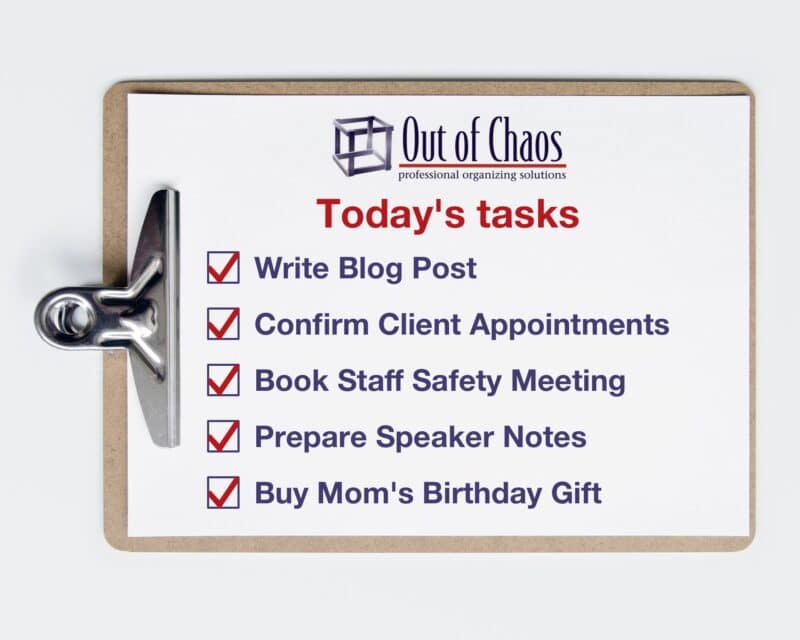
People tell us to make lists of things we should accomplish. Yet, we often get overwhelmed when we start making these long lists of tasks. Then, we end up berating ourselves because we can’t complete them. The problem: a list is not a system. It’s just a brain dump of what you want to accomplish. To make your to-do list work for you, implement project management strategies using my B-CLEAR process.
Bring It Together
You may have lists of tasks in different Reminder apps, email inboxes, notebooks, or whiteboards. So, the first step is to bring your tasks together in one place. If your tasks are all listed in your head, it’s time to get them out of there and write them down onto paper –physical paper or a document on your computer. Either way, get them all in one place.
It may take a few hours, but don’t think of it as time lost. Remember what Granny used to say, “A stitch in time saves nine.” The time you spend preparing your list will save you time – and reduce stress later on.
Categorize
Group your tasks into categories. First, focus on creating broad categories, then separate them into sub-categories. Take a look at this structure:
Home
- Home Maintenance
- Weekly Housecleaning Tasks
- Seasonal Maintenance
- Bathroom Renovation
- Auto Maintenance
- Weekly Maintenance
- Seasonal Maintenance
- Personal Finances
- Monthly Banking & Bill Payments
- Long-term Savings Plans
Work
- Work for Clients
- Client One
- Client Two
- Business Admin
- Weekly Bookkeeping
- Monthly Taxes & Payroll
- Long-term Marketing Strategy
Life & Leisure
- Yoga
- Piano Lessons
Some of these items will be long-term, and others will be short-term. You can label them as you classify them.
Limit
At this point, most people get overwhelmed because the list keeps getting longer and longer. But it is essential to limit what you need to do. In other words, look at what tasks you can delete or delegate. You might delegate some housework duties to children or a housekeeper. Perhaps co-workers could manage some client projects or administration jobs.
Estimate
Estimate how long each task will take. Remember that any job with more than two steps is a project. Break each project into single steps and write down the time estimate for each step. For example, “Book Business Trip for October 8th” might break down to:
- Reserve hotel (10 minutes)
- Book train ticket (10 minutes)
- Research restaurants in the area around the hotel and meeting venue (30 minutes)
You may feel you cannot estimate the time for some tasks. That’s okay. Give it your best guess, then add about 50% more time. If you think it will take an hour, estimate 90 minutes. It is easier to adjust downwards than upwards.
Allocate
Next, get all of your tasks into a To-Do List system. There are hundreds of apps and add-ons to apps that can manage this for you. Choose a system that:
- is easy to use
- syncs across all of your devices
- allows you to create multiple lists
- allows you to add different priority levels
Another feature to look for is the ability to access location services so it can send you a reminder when you are at a specific place. For example, when you visit the coffee shop, the system will remind you to pick up your dry cleaning in the building next door.
Now that you have a system, add your tasks to your defined categories, with each category as a separate list. To make your to-do list work for you, add details in the “notes” section, such as phone numbers, email addresses, or other information you might need to complete the task quickly. Your future self will thank you for making the job easier.
Reminders & Revision
In the previous step, you determined how long each task would take. Now, think about when the Due Date is, and set a reminder for the Do Date.
No, that was not a typo! A ‘do date‘ is when you need to work on the item to get it done before the ‘due date.‘ In the previous example of the business trip with a due date of October 8th, we have to set the ‘do dates’ long before that – especially if we know it is a busy holiday weekend. The task list might look like this:
- Reserve hotel (10 minutes) – September 1st
- Book train ticket (10 minutes) – September 1st
- Research restaurants in the area around the hotel and meeting venue (30 minutes) – October 1st
Use repeating events to your advantage. Most to-do list apps will allow you to create regular (yearly, monthly, weekly, and daily) repeating events and custom repeating events, such as twice per week or once per quarter. You can set it and forget it because your to-do list will remind you when you need to do it again.
Set priorities for tasks as you enter them into your system. Then, at the beginning of each week, you can revise your priorities based on new items you have added. For example, you must book your train and hotel for your business trip, but if you have a major project due on September 3rd, it will take precedence over planning your trip.
The B-CLEAR to-do system (a system, not a list!) will give you a feeling of accomplishment and increase your productivity with less stress. If you want to make your to-do list work for you, contact Out of Chaos today.
Clipboard image by BRRT on Pixabay.
